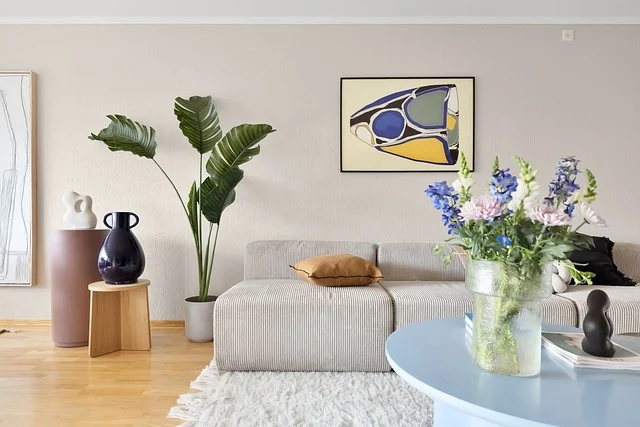
Biophilic design is an interior design philosophy focused on reconnecting people with nature by incorporating natural elements into indoor spaces. The term originates from “biophilia,” referring to our instinctual love for nature and living systems. As modern society spends more time indoors, this design approach promotes well-being by bringing elements of the natural world into our homes. With the rising demand for healthier living environments, biophilic design is gaining popularity as a powerful strategy for creating peaceful and restorative spaces.
In recent years, the global pandemic highlighted the importance of our living spaces, transforming homes into personal sanctuaries. Extended periods spent indoors led people to search for ways to enhance their environments, spurring the revival of biophilic design. This design style incorporates natural elements that improve air quality, elevate mood, and provide a sense of serenity.
Bring Nature In: A Guide to Biophilic Design
Incorporating biophilic elements into your home has numerous positive effects on both mental and physical well-being. Here are some of the main benefits:
Improved Mental Health:
Working or living in spaces designed with biophilic principles has been shown to improve emotional well-being. Surrounding yourself with nature-inspired decor and materials helps elevate mood, reduce symptoms of depression, and promote positive emotional experiences.
Increased Productivity and Focus:
Biophilic design enhances cognitive function by reducing distractions and creating environments that foster a connection with nature. Whether at work or school, such settings boost concentration, creativity, and overall productivity.
Better Indoor Air Quality
Adding indoor plants within biophilic spaces helps clean the air by filtering pollutants and increasing oxygen levels. This results in a healthier environment that supports better breathing and overall physical wellness.
Reduction in Stress Symptoms:
Environments that incorporate biophilic design elements such as greenery, water features, and natural light are known to ease stress and promote relaxation. These nature-rich settings foster a sense of calm, helping reduce anxiety and create a peaceful atmosphere.
Supports Better Sleep
Incorporating more natural light into living spaces helps regulate your body’s internal clock, improving sleep patterns and leading to more restful nights. This alignment with natural light cycles contributes to better overall health.
5 Simple Ways to Use Biophilic Design in Your Home
1 out of 5Add Indoor Plants for a Natural Touch
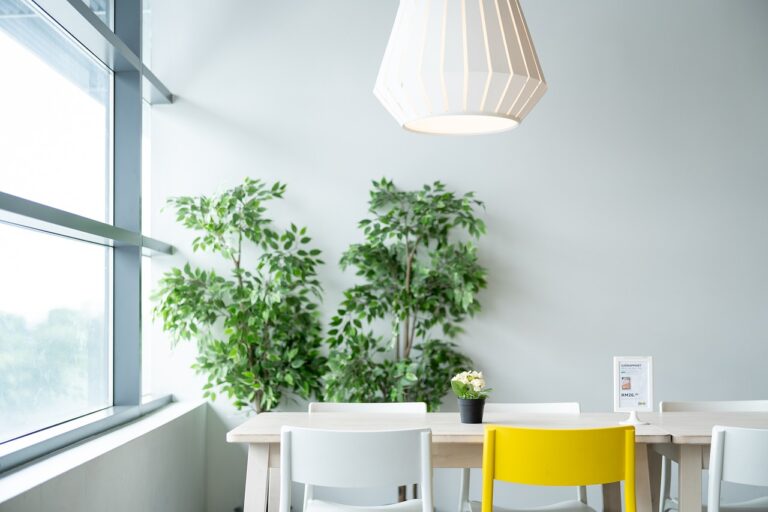
A simple yet effective way to introduce biophilic design is by incorporating indoor plants throughout your home. Plants not only bring nature indoors but also improve air quality and create a calming atmosphere. From small potted plants to larger statement plants, you can add greenery to any room. Consider creating a living wall for a bolder touch—a vertical garden that introduces lush greenery without taking up too much space.
Choose plants that thrive indoors, such as snake plants, succulents, or pothos. Use a variety of pots and planters to complement your decor and further integrate the natural elements.
2 out of 5Let More Natural Light Into Your Home
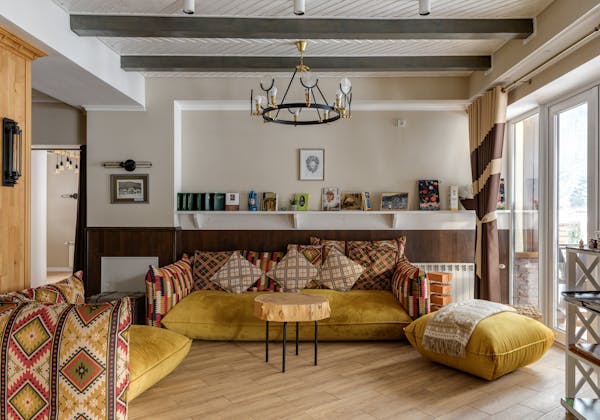
Maximizing natural light is essential in biophilic design as it mimics the rhythms of nature. Remove heavy curtains and opt for lighter, more transparent window treatments, or install skylights to invite more light into your home. Large windows that allow sunlight to pour in and offer views of the outdoors create a stronger connection with nature.
If outdoor views are not possible, consider using mirrors to reflect light and open up the space. You can also introduce nature-inspired artwork or photography that showcases landscapes and outdoor scenes, helping to evoke the feeling of being outdoors.
3 out of 5Connect Your Indoor and Outdoor Spaces
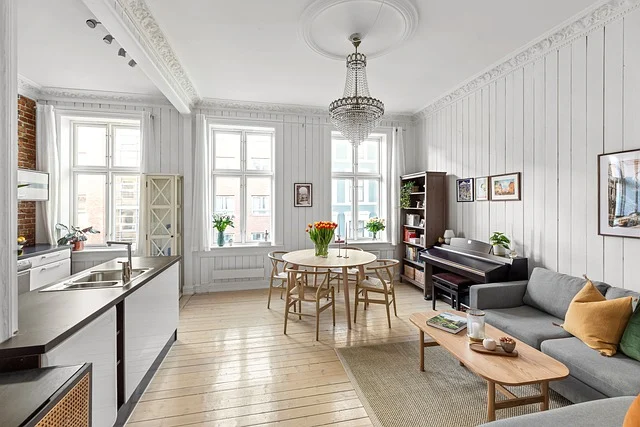
One of the core tenets of biophilic design is creating smooth transitions between indoor and outdoor areas. You can achieve this by installing large glass doors that allow for a visual and physical connection between the two spaces. French doors or sliding glass doors create a harmonious flow between your indoor living space and a garden or patio.
Even in smaller spaces, adding a cozy balcony garden or outdoor seating area can enhance your connection with nature. By merging indoor and outdoor spaces, you create an environment that encourages fresh air and sunlight to enter your home.
4 out of 5Use Natural Materials and Earthy Colors
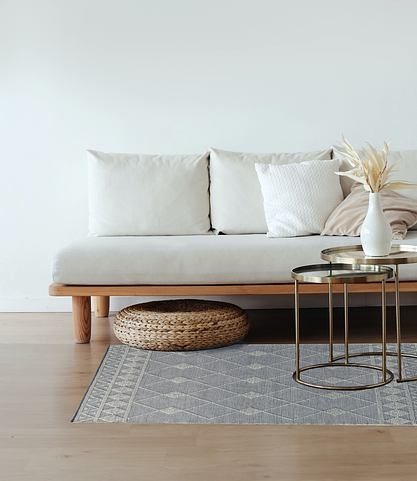
Using natural materials like wood, stone, and bamboo is central to biophilic design. These materials evoke a sense of warmth and a connection to the natural world. Opt for sustainable options, such as reclaimed wood furniture, to enhance your home while being eco-conscious.
Choose earthy color palettes that reflect nature, like soft greens, warm browns, and neutral tones. These hues create a calming atmosphere and complement natural materials. Incorporate textured fabrics such as jute rugs, linen curtains, and woven baskets to add depth and a tactile connection to nature.
5 out of 5Add Water Features for a Calming Effect

Water is another powerful natural element that can enhance the tranquility of your home. Introducing water features, such as indoor fountains, aquariums, or small tabletop water bowls, can create a calming atmosphere by bringing the soothing sound and visual effect of water into your space. The gentle flow of water can reduce stress and evoke a sense of relaxation, further deepening your connection to nature. These features can be as simple or elaborate as you like, depending on the size and style of your home.
conclusion
Biophilic design is more than just a trend—it’s a movement that promotes healthier, more sustainable living environments. By incorporating natural elements, optimizing light, and using natural materials, you can transform your home into a peaceful retreat that nourishes both body and mind.
Even small changes, like adding plants or enhancing natural light, can have a profound impact on your space. As more people discover the benefits of biophilic design, this approach to decorating is set to become a lasting element in modern interior design, helping individuals reconnect with nature within the comfort of their homes.
FAQ
Can biophilic design be integrated on a budget?
Yes, affordable biophilic design can be achieved with simple, budget-friendly solutions. Adding potted plants, maximizing natural light, using organic textures, and incorporating nature-inspired decor such as wood furniture, natural color schemes, and earthy materials can create a connection with nature without a large investment. Even small biophilic touches can have a big impact on well-being and the overall ambiance of a space.
Does biophilic design increase property value?
Yes, integrating biophilic design elements such as natural lighting, indoor greenery, and outdoor living spaces can increase a property’s aesthetic appeal and market value. Nature-inspired interiors not only improve the well-being and mental health of occupants but also enhance the overall appeal of a space, making biophilic architecture a key selling point in today’s real estate market.
What Is Biophilic Design?
Biophilic design goes beyond simply adding plants to a room; it’s about creating spaces that nurture our connection to nature. It is built by integrating natural elements like indoor plants, water features, or natural light into your home. These elements enhance the visual appeal and have scientifically proven benefits, such as reducing stress and boosting creativity.
Is biophilic design sustainable?
Yes, biophilic design supports sustainability by using eco-friendly materials like wood, stone, and natural fabrics. It often includes energy-efficient lighting and green building methods. Adding living plants can help improve air quality and make the space more energy-efficient, creating a more sustainable environment overall.










